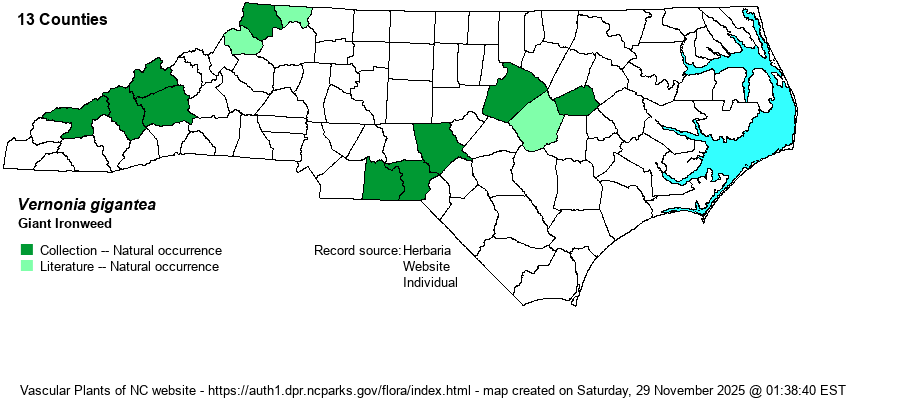| Section 6 » Order Asterales » Family Asteraceae |
Show/Hide Synonym
| taxonName | relationship | relatedTaxonName | relatedTaxonRefText | relComments |
|---|
|
|
|
|
| Vernonia gigantea | = | Vernonia gigantea ssp. gigantea | | | | Vernonia gigantea | = | Vernonia gigantea ssp. gigantea | Vascular Flora of the Southeastern States (Cronquist 1980, Isely 1990) | | | Vernonia gigantea | = | Vernonia gigantea ssp. gigantea | Jones in Cronquist (1980)=SE. Key based on FNA and SE. | | | Vernonia gigantea | = | Vernonia altissima | Gleason (1952) | | | Vernonia gigantea | = | Vernonia altissima | Radford, Ahles, and Bell (1968) | | | Vernonia gigantea | = | Vernonia altissima | Flora of West Virginia | | | Vernonia gigantea | = | Vernonia gigantea var. gigantea | Gleason and Cronquist (1991) | | | Vernonia gigantea | > | Vernonia altissima var. altissima | Fernald (1950) | | | Vernonia gigantea | > | Vernonia altissima var. taeniotricha | Fernald (1950) | | | Vernonia gigantea | < | Vernonia gigantea | Flora of North America (1993b, 1997, 2000, 2002a, 2002b, 2003a, 2004b, 2005, 2006a, 2006b, 2006c, 2007a, 2009, 2010) | | | Vernonia gigantea | < | Vernonia gigantea | Wunderlin & Hansen Flora of Florida (3) | | | Vernonia gigantea | > | Vernonia gigantea var. gigantea | | | | Vernonia gigantea | > | Vernonia gigantea var. "taeniotricha" | | , nomen nudum | | Vernonia gigantea | > | Vernonia altissima | Small (1933, 1938) | | | Vernonia gigantea | > | Vernonia gigantea | Small (1933, 1938) | | | Source: Weakley's Flora |
|
| Author | (Walter) Trelease | |
| Distribution | Confusing and unsettled. This is a species that is easily overlooked among V. noveboracensis, a common NC species. The county range map below is almost certainly incomplete, but some county "records" far east of the Mountains might well be open to question. On the other hand, given the habitat availability, there seems no reason -- if the Fall Line records are correct -- for it not also to be present across most of the Piedmont. The BONAP map also includes Alleghany and Watauga counties, reasonable given the overall range (included on the map) and Bladen County (likely out of range and not included on the map below). Nonetheless, this species is genuinely rare east of the TN-NC state line, and also rather scarce in VA but yet widespread in WV. Contrarily, V. noveboracensis is genuinely scarce in TN and the western half of WV, yet found in nearly every county in VA and NC! The BONAP maps for these two species show this dichotomy very well. Review of iNaturalist photos purported to be this species is not practical.
NY to NE, south to SC, northern FL, and TX. | |
| Abundance | Probably rare in the Mountains, and very rare in the Piedmont, Sandhills, and western Coastal Plain. A small population (15 plants) was discovered in the Piedmont of Moore County in September 2020; plants ranged from 6-9 feet tall. Another small population was discovered and photographed in Johnston County by K. Taylor (photos on Facebook), also in September 2020. Becky Dill vouchered a population in Anson County in 2022; and a population was photographed in Wilson County in 2023 by Mark Basinger. This should be a Significantly Rare species or at a minimum a Watch List species, but NCNHP does not have it on either list (and does not yet have a State Rank for it). The website editors have given it a W7 status (Rare but poorly known). The S2? State Rank suggested by the editors is a rough guess, based on the fact that it should not be overly rare in the mountains. | |
| Habitat | Moist to wet soil of marshes, streamsides, wet meadows, low spots in pastures. | |
| Phenology | Flowering and fruiting August-October. | |
| Identification | Giant Ironweed is indeed tall -- up to 7 or more feet. Leaves are numerous and shaped like those of New York Ironweed (V. noveboracensis), which is far more commonly encountered in NC. It is best told from the latter by fewer-flowered heads (9-30 vs. 30-50) and acute to blunt tips of involucral bracts (vs. acuminate). This species also is downy on the underside of the leaves, whereas New York Ironweed is smooth. Also, the involucre is shorter (less than 7 mm) and florets fewer (less than 30) than in New York Ironweed. This species is presumably overlooked in the mountains among the quite common New York Ironweed. Both species are quite majestic in bloom. | |
| Taxonomic Comments | Treated as V. altissima in RAB (1968) and many other references.
| |
| Other Common Name(s) | Tall Ironweed. Note that many references use Tall Ironweed for the shorter and much more slender V. angustifolia. As a result, the website editors wish to avoid confusion with common names, and use Slender Ironweed for this latter species. | |
| State Rank | [S2?] | |
| Global Rank | G5 | |
| State Status | [W7] | |
| US Status | | |
| USACE-agcp | FAC link |
| USACE-emp | FAC link |

